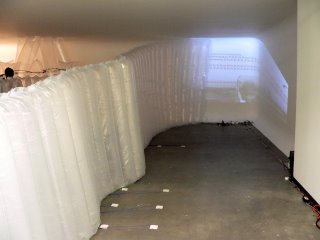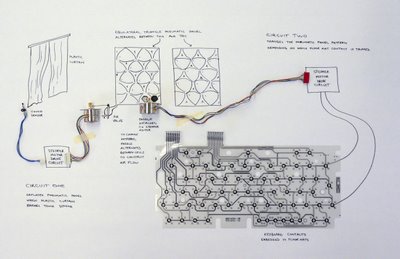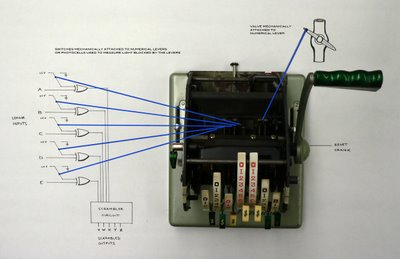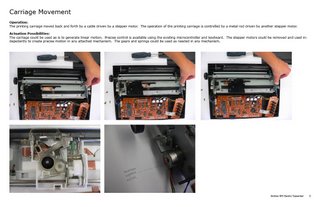I came across this link today: Sketching in Thin Air
Using video cameras and motion capture, the Front design group is able to "sketch" in three dimensions. The captured sketches can be fed into a digital prototyping system to produce a physical object.
Sunday, October 29, 2006
Thursday, October 26, 2006
To Montreal and Back
We had a great trip to Montreal. RPI brought one huge pneumatic wall to which we interfaced our electronics. The installation became a whale-like creature, which breathed with the help of shop-vacs attached to each side of the wall.

A light sensor controlled the rate of breathing (this was the "breathing eye" of the creature). The whole structure would curve and lean to one side depending on which side of the wall was being inflated. Contacts placed between the air cells of the wall activated my electric typewriter and Chelsea's "Let's Pretend Elmo" doll. As the contacts were activated, the typewriter would record of the movement of the wall as keystrokes. A camera pointed at the typewriter sent video to a projector that projected the creature's writing onto the installation space and triggered its "breathing eye". Dana's magnetic tape head was attached to the typewriter and moved along a strip of magnetic tape as the carraige moved back and forth.
Elmo was embedded into the end cell of the structure and would spontaneously cry out and wiggle as its contacts were activated. Kyle's optical theremin was attached to Elmo, causing its sound output to vary in reponse to Elmo's movement and the movement of people in the space.
Seen as a whole, the installation could be seen as a strange beached whale, desperately calling for help using the typewriter, but not knowing the right keys to press. The creature generated cryptic whale songs using the magnetic tape head and optical theremin, while a partially digested Elmo wriggled inside.

A light sensor controlled the rate of breathing (this was the "breathing eye" of the creature). The whole structure would curve and lean to one side depending on which side of the wall was being inflated. Contacts placed between the air cells of the wall activated my electric typewriter and Chelsea's "Let's Pretend Elmo" doll. As the contacts were activated, the typewriter would record of the movement of the wall as keystrokes. A camera pointed at the typewriter sent video to a projector that projected the creature's writing onto the installation space and triggered its "breathing eye". Dana's magnetic tape head was attached to the typewriter and moved along a strip of magnetic tape as the carraige moved back and forth.
Elmo was embedded into the end cell of the structure and would spontaneously cry out and wiggle as its contacts were activated. Kyle's optical theremin was attached to Elmo, causing its sound output to vary in reponse to Elmo's movement and the movement of people in the space.
Seen as a whole, the installation could be seen as a strange beached whale, desperately calling for help using the typewriter, but not knowing the right keys to press. The creature generated cryptic whale songs using the magnetic tape head and optical theremin, while a partially digested Elmo wriggled inside.
Wednesday, October 11, 2006
The Montreal Proposal
As an FYI for those who don't know, we're going to Montreal to meet up with another architecture school (RPI from Troy, NY). We will combine our work with RPI's pneumatic structures to create some theatrical installation. Our studio has been broken into groups to work on developing a response to RPI's structures.
I am working with Chelsea, Dana and Kyle to develop a response to the work of Erica, China, Barbara and Matt at RPI. They are proposing to build 3 darted/pleated wall sections. Each wall has two air panels. The wall would curve and "stand up" as one of the air panels is inflated. Deflating that panel and inflating the other one would cause the wall to curve the opposite way.
I propose using the electric typewriter as an output device that would record the motions of the whole wall system. The keyboard of the typewriter would be interfaced with switches placed throughout and around the walls, so that as the walls move, the switches are tripped and send keystrokes to the typewriter. The typewriter would type out the actions of the whole system (in gibberish). The typewriter could also take sensor input from Chelsea's Elmo doll to record its actions as well.
I am working with Chelsea, Dana and Kyle to develop a response to the work of Erica, China, Barbara and Matt at RPI. They are proposing to build 3 darted/pleated wall sections. Each wall has two air panels. The wall would curve and "stand up" as one of the air panels is inflated. Deflating that panel and inflating the other one would cause the wall to curve the opposite way.
I propose using the electric typewriter as an output device that would record the motions of the whole wall system. The keyboard of the typewriter would be interfaced with switches placed throughout and around the walls, so that as the walls move, the switches are tripped and send keystrokes to the typewriter. The typewriter would type out the actions of the whole system (in gibberish). The typewriter could also take sensor input from Chelsea's Elmo doll to record its actions as well.
Thursday, October 05, 2006
Possibilities
I worked out a couple of possibilities for turning the electric typewriter and cheque imprinter into devices that can interact with RPI's pneumatic structures.
The first is the "Equilateral Typewriter." This mechanism would provide an articulation in a pneumatic panel surface which changes over time and in response to people walking around the panel.

This mechanism is designed to interact with RPI's equilateral triangle pneumatic panel, which has the possibility of configuring itself into different hexagon patterns depending on which air cell is inflated first. A touch sensor, possibly triggered by someone pushing aside a plastic curtain, would partially deflate the panel by opening a valve. The typewriter's keyboard contacts would be placed into floor mats around the panel. A paddle or some other device that could constrict an air cell would be attached to a stepper motor (activated by the floor mat sensors). The paddle would be used to constrict one of two cells, depending on which floor mat sensor was activated. It is hoped that this constriction control would allow the panel to alternate between two different hexagon patterns. The panel would inflate again after some period of time, into the hexagon pattern determined by the action of someone walking over the floor mat sensors. The mechanism could be modified to interact with other types of pneumatic structures as well.
The "Paymaster Enigma" would be used to scramble sensor inputs and redirect them to various mechanisms. This device could take input from any sensor in the entire installation and redirect it to one or more devices. This could add to the theatrical quality of the installation, since the outcome of a sensor interaction would not be easily predictable.

The mechanism is inspired by the Enigma code machine used by Germany to encrypt communications during World War II. The numerical levers of the cheque imprinter would be interfaced with switches or photocells. A circuit would be used to scramble the sensor inputs based on the positions of the numerical levers. The crank of the cheque imprinter would be used to reset the levers.
A variable resistor could also be mechanically attached one of the numerical levers. This could be used by a circuit to control the intervals between when certain pneumatic structures are deflated or inflated. For example, when a lever is at its lowest position, a structure could be set to deflate every 20 minutes. With the lever at its highest position, it may deflate every 20 seconds.
My accordion is here at the bus depot, waiting to be picked up. I will begin to experiment with it tomorrow. I'm hoping that tubes could be attached to the accordion to capture the air moving in and out of the instrument. The air could be redirected to a small air cell that could move a pneumatic door or panel. It might be possible to hook up tubes to many parts of the installation, so that the accordion could be used to "play" the architecture.
The first is the "Equilateral Typewriter." This mechanism would provide an articulation in a pneumatic panel surface which changes over time and in response to people walking around the panel.

This mechanism is designed to interact with RPI's equilateral triangle pneumatic panel, which has the possibility of configuring itself into different hexagon patterns depending on which air cell is inflated first. A touch sensor, possibly triggered by someone pushing aside a plastic curtain, would partially deflate the panel by opening a valve. The typewriter's keyboard contacts would be placed into floor mats around the panel. A paddle or some other device that could constrict an air cell would be attached to a stepper motor (activated by the floor mat sensors). The paddle would be used to constrict one of two cells, depending on which floor mat sensor was activated. It is hoped that this constriction control would allow the panel to alternate between two different hexagon patterns. The panel would inflate again after some period of time, into the hexagon pattern determined by the action of someone walking over the floor mat sensors. The mechanism could be modified to interact with other types of pneumatic structures as well.
The "Paymaster Enigma" would be used to scramble sensor inputs and redirect them to various mechanisms. This device could take input from any sensor in the entire installation and redirect it to one or more devices. This could add to the theatrical quality of the installation, since the outcome of a sensor interaction would not be easily predictable.

The mechanism is inspired by the Enigma code machine used by Germany to encrypt communications during World War II. The numerical levers of the cheque imprinter would be interfaced with switches or photocells. A circuit would be used to scramble the sensor inputs based on the positions of the numerical levers. The crank of the cheque imprinter would be used to reset the levers.
A variable resistor could also be mechanically attached one of the numerical levers. This could be used by a circuit to control the intervals between when certain pneumatic structures are deflated or inflated. For example, when a lever is at its lowest position, a structure could be set to deflate every 20 minutes. With the lever at its highest position, it may deflate every 20 seconds.
My accordion is here at the bus depot, waiting to be picked up. I will begin to experiment with it tomorrow. I'm hoping that tubes could be attached to the accordion to capture the air moving in and out of the instrument. The air could be redirected to a small air cell that could move a pneumatic door or panel. It might be possible to hook up tubes to many parts of the installation, so that the accordion could be used to "play" the architecture.
Monday, October 02, 2006
Electric Type
Here's a video of the naked electric typewriter in operation:
I've documented the "engineering" of the cheque imprinter and the electric typewriter. Click the images below to download the entire documents.


The accordion won't be shipped out until Wednesday or Thursday. Here's a picture of it in the meantime.

Air being pushed out of the accordion bellows could be used to inflate a pneumatic device. It may be possible to use the accordion keys to "fine tune" the flow of air.
I've documented the "engineering" of the cheque imprinter and the electric typewriter. Click the images below to download the entire documents.


The accordion won't be shipped out until Wednesday or Thursday. Here's a picture of it in the meantime.

Air being pushed out of the accordion bellows could be used to inflate a pneumatic device. It may be possible to use the accordion keys to "fine tune" the flow of air.
Subscribe to:
Posts (Atom)